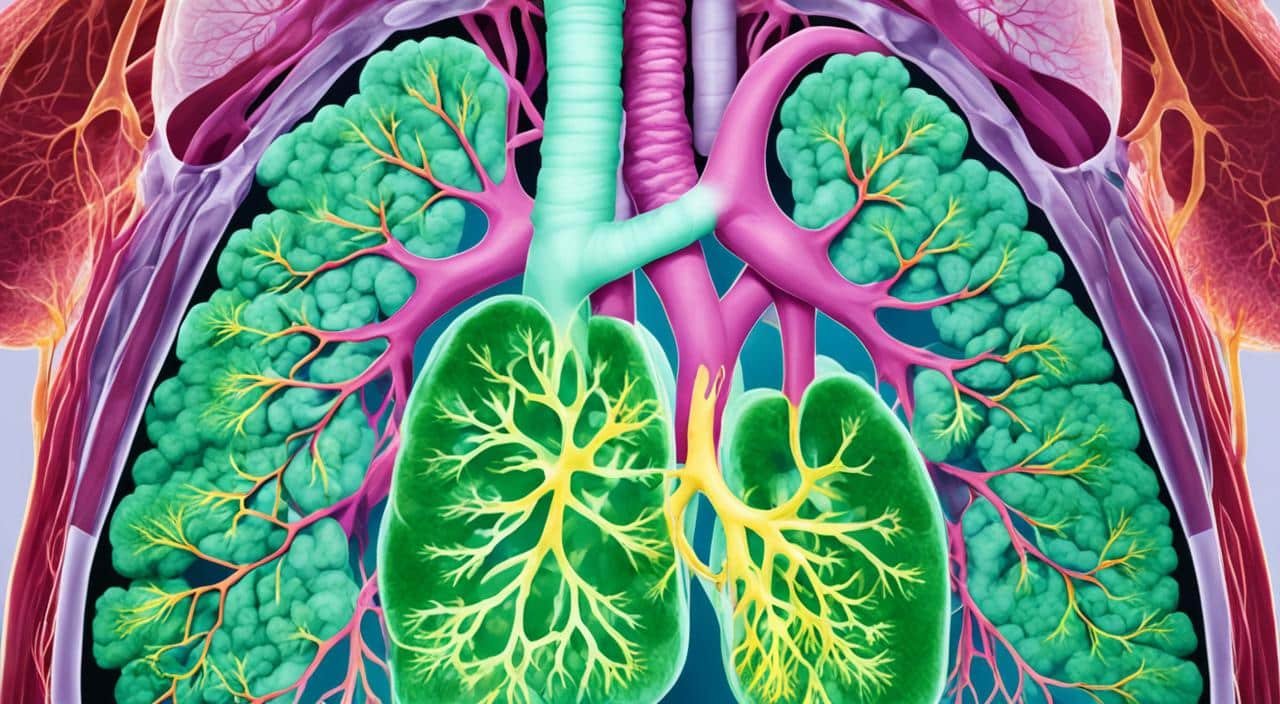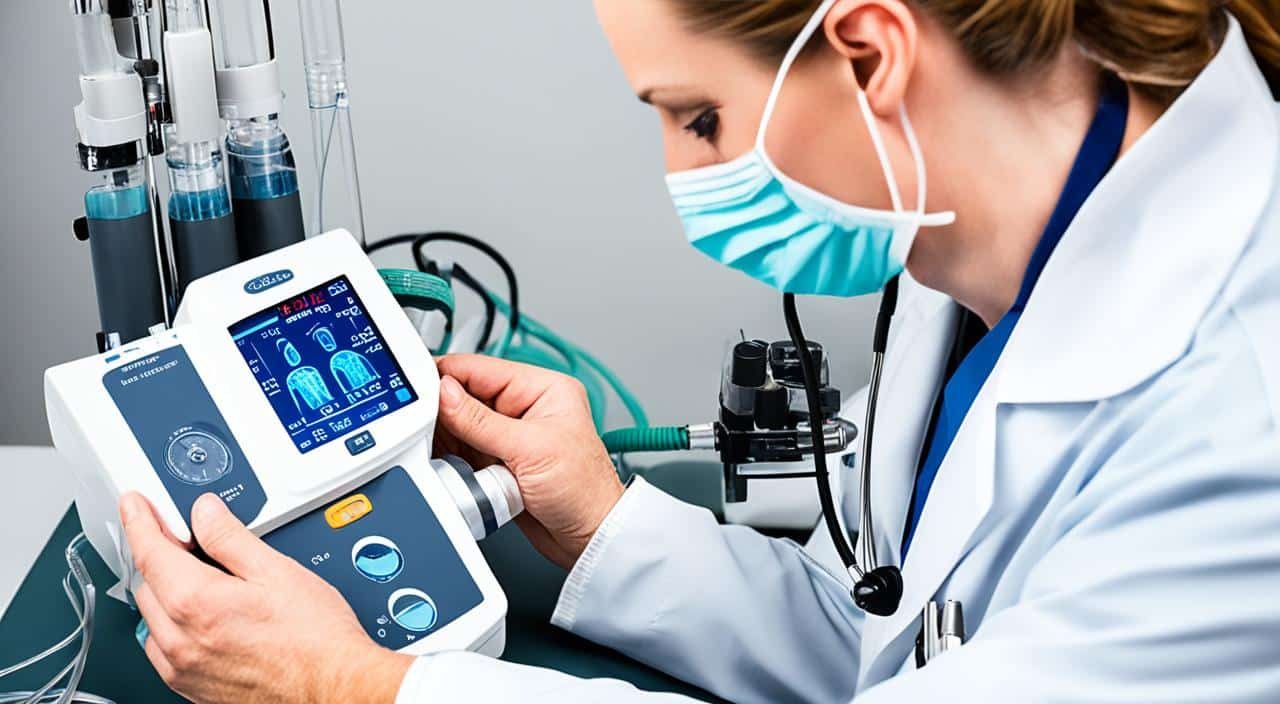Lung disease covers any issue that affects the lungs and how they work. It includes airway problems, issues with lung tissue, and diseases of the lung’s circulation. Knowing about these common lung diseases is key to keeping your lungs healthy and catching problems early.
Key Takeaways
- Lung diseases can affect the airways, lung tissue, or lung circulation, leading to breathing difficulties and respiratory problems.
- The most common lung diseases include asthma, chronic obstructive pulmonary disease (COPD), lung cancer, pneumonia, pulmonary fibrosis, and pulmonary hypertension.
- Lung diseases can be caused by a variety of factors, including genetic predisposition, environmental exposures, and lifestyle choices.
- Early diagnosis and appropriate treatment are essential for managing lung diseases and preventing further complications.
- Regular checkups, lifestyle modifications, and adherence to medical recommendations can help maintain healthy lung function.
Understanding Lung Diseases
The human respiratory system is key for breathing. It’s a complex network. Within it, different lung diseases can happen. Each has its own effects on breathing.
Types of Lung Diseases
Lung diseases fall into three main groups:
- Airway diseases: These affect the air tubes, causing them to narrow or block. This makes breathing hard.
- Lung tissue diseases: These harm the lung’s structure. It’s hard for the lungs to expand and exchange gases.
- Lung circulation diseases: These impact the blood vessels in the lungs. They affect oxygen uptake and carbon dioxide release.
Impact on Respiratory Function
Lung diseases can greatly affect breathing. They can cause breathing problems and even respiratory failure. The severity depends on the disease, its progress, and the person’s health and lung function.
“Lung diseases can profoundly affect an individual’s ability to breathe and perform daily activities. Understanding the different types and their impact on the respiratory system is crucial for effective management and treatment.”
Knowing about lung diseases and their effects helps both individuals and healthcare workers. It leads to better lung health and overall well-being.
Also Read : What Are Common Lung Diseases?
Airway Diseases

Airway diseases are conditions that affect the airways. These tubes carry oxygen and gases in and out of the lungs. They can narrow or block, making breathing hard. Asthma and chronic obstructive pulmonary disease (COPD) are common ones.
Asthma
Asthma is a condition where airways swell and get sensitive. This leads to coughing, wheezing, chest tightness, and shortness of breath. Many things can trigger asthma, like allergens, exercise, cold air, and stress. Managing asthma means taking medicine, making lifestyle changes, and avoiding triggers.
Also Read : What Is A Loan Principal?
Chronic Obstructive Pulmonary Disease (COPD)
COPD is a lung disease that gets worse over time. It includes emphysema and chronic bronchitis, which block airflow and make breathing hard. Symptoms are coughing a lot, making a lot of mucus, wheezing, and feeling short of breath. Things like smoking, air pollution, and certain dusts at work can cause COPD.
| Characteristic | Asthma | COPD |
|---|---|---|
| Airway Inflammation | Intermittent and reversible | Persistent and progressive |
| Airflow Limitation | Variable and often reversible | Persistent and not fully reversible |
| Onset | Often starts in childhood | Usually develops in adulthood |
| Triggers | Allergens, exercise, stress | Tobacco smoke, air pollution, occupational dusts |
Knowing the differences between asthma and COPD helps with diagnosis and treatment. If you have ongoing or getting worse breathing problems, see a doctor for help.
Also Read :Is A Personal Loan The Right Choice For You?
Lung Tissue Diseases
Lung tissue diseases affect the lungs’ structure and function. They can cause scarring or inflammation, leading to restrictive lung disease. This makes it hard for the lungs to expand and breathe properly.
Pulmonary fibrosis and sarcoidosis are common lung diseases. Pulmonary fibrosis means scar tissue builds up in the lungs, slowly harming lung function. Sarcoidosis is an inflammatory disease that can hit the lungs and other organs, causing granulomas.
Pulmonary Fibrosis
Pulmonary fibrosis is a chronic lung disease. It makes the lungs stiff and less expandable, causing breathing problems and low oxygen levels. The cause is often unknown but can be linked to genes, environmental factors, or other health issues.
Sarcoidosis
Sarcoidosis is an inflammatory disease that can affect many organs, including the lungs. It happens when the immune system overreacts, forming inflammatory cells called granulomas. These can cause lung inflammation and scarring, hurting lung function. The exact cause is still a mystery but thought to involve genes and environment.
“Lung tissue diseases can have a significant impact on a person’s quality of life, making it crucial to seek prompt medical attention and follow a comprehensive treatment plan.”
Also Read : How Does Insurance Protect Me?
Lung Circulation Diseases
Lung circulation diseases affect the blood vessels in the lungs. They can make it hard for the lungs to exchange oxygen and carbon dioxide. This can hurt the heart’s function. Pulmonary hypertension is a well-known lung circulation disease.
Pulmonary Hypertension
Pulmonary hypertension is a condition with high blood pressure in the lungs’ arteries. This pressure makes the blood vessels narrow, stiff, or scarred. It’s harder for the heart to pump blood through the lungs.
The heart works harder, which can cause right-sided heart failure. This condition can be caused by genes, lung diseases, blood clots, or heart defects at birth. Symptoms include shortness of breath, feeling tired, chest pain, and swelling in the legs or belly.
It’s important to diagnose and treat pulmonary hypertension early. This helps prevent damage to the lungs and heart. Treatment may include medicines, oxygen therapy, and surgery to improve blood flow.
| Symptoms of Pulmonary Hypertension | Causes of Pulmonary Hypertension |
|---|---|
|
|
Keeping the lungs healthy is key for heart health. Understanding lung circulation diseases and getting medical help early is important. This helps manage lung health and improve life quality.
Also Read: What Are Asthma Symptoms?
Lung Disease
Lung disease covers many conditions that affect the lungs. These can cause breathing problems, damage to lung tissue, and circulatory issues. It’s a big health concern, affecting millions globally and leading to many deaths.
The lungs are key for our health, exchanging oxygen and carbon dioxide. When lung disease hits, it can greatly affect someone’s life and health. Knowing about lung diseases helps us prevent and treat them better.
Types of Lung Diseases
- Airway Diseases: Conditions that affect the airways, such as asthma and chronic obstructive pulmonary disease (COPD).
- Lung Tissue Diseases: Disorders that primarily impact the lung tissue, including pulmonary fibrosis and sarcoidosis.
- Lung Circulation Diseases: Conditions that affect the blood vessels in the lungs, such as pulmonary hypertension.
Respiratory System Impacts
Lung diseases can really affect the lungs, causing symptoms like:
- Difficulty breathing
- Reduced lung capacity and oxygen intake
- Chronic coughing and wheezing
- Lung tissue damage and scarring
- Impaired blood circulation and oxygenation
Knowing about lung diseases and their effects helps doctors, patients, and everyone else. It leads to better detection, management, and quality of life for those with these conditions.
| Lung Disease | Description | Respiratory Impact |
|---|---|---|
| Asthma | An airway disease that causes inflammation and narrowing of the airways. | Difficulty breathing, wheezing, coughing, and chest tightness. |
| COPD | A group of progressive lung diseases that obstruct airflow, including emphysema and chronic bronchitis. | Shortness of breath, persistent cough, and reduced lung function. |
| Pulmonary Fibrosis | A lung tissue disease characterized by scarring and stiffening of the lung tissue. | Decreased lung capacity, dry cough, and difficulty breathing. |
“Lung diseases can have a profound impact on an individual’s quality of life, but with proper diagnosis and treatment, many patients can manage their conditions and maintain an active, healthy lifestyle.”
Lung Cancer

Lung cancer is a serious and common lung disease. It happens when abnormal cells grow out of control in the lungs. This can make it hard for the lungs to work right. Knowing the risk factors and symptoms is key for catching it early and treating it well.
Risk Factors and Symptoms
Smoking, secondhand smoke, and air pollution are big risks for lung cancer. Smoking is the main cause, making up about 80% of cases. Being around secondhand smoke and pollutants like radon and asbestos also raises the risk.
Signs of lung cancer include a cough that won’t go away, chest pain, trouble breathing, and coughing up blood. These signs can be like other lung problems, making it hard to spot lung cancer early. It’s important to see doctors often and talk about any health concerns.
| Risk Factor | Description |
|---|---|
| Smoking | Cigarette smoking is the leading cause of lung cancer, accounting for around 80% of all cases. |
| Secondhand Smoke | Exposure to secondhand smoke can also increase the risk of developing lung cancer. |
| Air Pollution | Exposure to various air pollutants, such as radon and asbestos, can contribute to the development of lung cancer. |
Finding lung cancer early and acting fast is key. Regular tests, like low-dose CT scans, can spot it early. People at high risk, like smokers or those with a family history, should talk to their doctors about screenings and prevention plans.
Pneumonia

Pneumonia is a serious illness that affects the lungs. It happens when bacteria, viruses, or fungi infect the lungs. This leads to inflammation and fluid buildup, making it hard to breathe. It can be very dangerous, especially for people at high risk.
Symptoms of pneumonia include:
- Cough
- Fever
- Chills
- Difficulty breathing
Pneumonia is a serious illness, especially for some groups. This includes the elderly, young kids, and people with weak immune systems or health issues.
| Pneumonia Causes | Symptoms | Risk Factors |
|---|---|---|
| – Bacterial infections – Viral infections – Fungal infections |
– Cough – Fever – Chills – Difficulty breathing |
– Age (young children or elderly) – Weakened immune system – Underlying health conditions |
Getting pneumonia diagnosed and treated early is key. If you think you or someone you know might have it, see a doctor fast. This helps get the right diagnosis and treatment.
“Pneumonia is a serious lung infection that can lead to life-threatening complications if not properly treated. Early diagnosis and intervention are key to a successful recovery.”
Bronchitis
Bronchitis is a condition that affects the bronchial tubes, which carry air to and from the lungs. When these tubes get inflamed and make too much mucus, it can cause a cough, wheezing, and shortness of breath. There are two main types: chronic bronchitis and acute bronchitis.
Chronic Bronchitis
Chronic bronchitis is a long-term condition with a persistent cough that brings up mucus. It often starts from repeated irritation or damage to the bronchial tubes. This can be from smoking, air pollution, or other lung problems. People with chronic bronchitis may have flare-ups that make their symptoms and breathing worse.
Acute Bronchitis
Acute bronchitis is a short-term inflammation of the bronchial tubes, usually caused by a virus or bacteria. Symptoms include a wet cough, chest pain, and sometimes fever and chills. Unlike chronic bronchitis, it’s a temporary condition that usually gets better in a few weeks with treatment and rest.
It’s important to know the difference between chronic and acute bronchitis to get the right medical care. Getting medical help quickly is key, as bronchitis can turn into something more serious like pneumonia if not treated.
| Characteristic | Chronic Bronchitis | Acute Bronchitis |
|---|---|---|
| Duration | Long-term, persistent | Short-term, temporary |
| Cause | Repeated irritation or damage to bronchial tubes | Viral or bacterial infection |
| Symptoms | Persistent cough, mucus production, frequent exacerbations | Wet, productive cough, chest discomfort, fever, chills |
| Treatment | Medications, lifestyle changes, oxygen therapy | Rest, over-the-counter medications, antibiotics (for bacterial infections) |
Cystic Fibrosis

Cystic fibrosis is a genetic disorder that mainly affects the lungs and digestive system. It causes thick, sticky mucus that blocks airways and traps bacteria. This leads to lung infections and breathing problems.
This disease comes from a genetic mutation that messes with a protein. This protein helps control salt and water in cells. Without it, the mucus becomes thick and sticky, a key symptom of cystic fibrosis.
Cystic fibrosis also hits the pancreas, liver, and other organs. It’s a complex disease needing careful management and treatment.
Symptoms and Complications of Cystic Fibrosis
The main signs of cystic fibrosis are:
- Persistent cough and phlegm production
- Frequent lung infections, such as pneumonia
- Digestive issues, including malnutrition and difficulty gaining weight
- Reproductive problems, including male infertility
Without treatment, cystic fibrosis can cause serious problems like respiratory failure and organ damage. But, thanks to medical advances, many people with the disease can live longer and manage their symptoms better.
| Symptom | Impact on the Body |
|---|---|
| Thick, sticky mucus | Clogs the airways and traps bacteria, leading to lung infections |
| Digestive issues | Malnutrition and difficulty gaining weight due to pancreatic problems |
| Reproductive problems | Male infertility and other reproductive challenges |
Cystic fibrosis is a complex genetic disorder needing ongoing care. Understanding its effects on the lungs helps patients and doctors work together. They can then create better treatment plans to improve life quality.
Environmental Factors
The air we breathe affects our lung health a lot. Things like air pollution and secondhand smoke can cause respiratory diseases. It’s important to know how these things affect our lungs to stay healthy.
Air Pollution and Lung Health
Air pollution includes things like dust, smoke, and ozone. These can make breathing problems worse, like asthma, chronic obstructive pulmonary disease (COPD), and lung cancer. They can make the lungs inflamed and work less well.
- Particulate matter, such as dust, soot, and smoke, can go deep into the lungs and cause inflammation and tissue damage.
- Ozone, a key component of smog, can irritate the respiratory system and make lung conditions worse.
- Other air pollutants, such as nitrogen oxides and sulfur dioxide, can also lead to respiratory diseases.
People living in polluted areas might face a higher risk of lung problems. Using air purifiers, staying inside when pollution is high, and pushing for cleaner air laws can help. These steps can lessen the harm to our lungs.
Secondhand Smoke and Lung Health
Secondhand tobacco smoke is bad for our lungs too. It has the same harmful chemicals as smoking and raises the risk of lung cancer and COPD. Even a little bit of secondhand smoke can hurt our lungs.
“Exposure to secondhand smoke is a leading cause of lung disease in non-smokers. Protecting yourself and your loved ones from this environmental hazard is crucial for maintaining respiratory health.”
Staying away from secondhand smoke helps keep our lungs healthy. Encouraging people to quit smoking and making places smoke-free can make a big difference.
Diagnosis and Treatment

Diagnosing and treating lung diseases takes a detailed approach. It includes many respiratory tests and tailored therapies. These tools and options are key in checking lung health, finding conditions, and making treatment plans for different respiratory issues.
Respiratory Tests
Here are some tests used to check lung health and spot lung diseases:
- Spirometry: This test measures how much and how fast air moves in and out of the lungs. It helps check lung function.
- Chest X-rays: These give clear pictures of the lungs. They can show problems or conditions inside.
- CT scans: These scans give detailed, three-dimensional pictures of the lungs. They help in making a precise diagnosis of lung problems.
- Lung biopsies: This involves taking a small piece of lung tissue for tests. It helps find the cause of lung diseases.
Therapies and Treatments
For lung diseases, treatments might include:
- Medications: Doctors may prescribe drugs like bronchodilators, corticosteroids, and antibiotics. These help manage symptoms and slow the disease.
- Oxygen therapy: This gives extra oxygen to help with breathing and keep blood oxygen levels up for those with breathing problems.
- Pulmonary rehabilitation: This is a program with exercises, education, and nutrition advice. It aims to improve lung function and quality of life.
- Lung transplantation: In very serious cases, a lung transplant might be an option for people with severe lung disease.
The right treatment plan depends on the lung disease type, its severity, and the patient’s health. Keeping a close watch on the treatment and making changes as needed is key to the best results for those with respiratory issues.
| Respiratory Test | Description | Purpose |
|---|---|---|
| Spirometry | Measures the volume and flow of air during inhalation and exhalation | Assesses lung function and helps diagnose respiratory conditions |
| Chest X-ray | Provides detailed images of the lungs | Reveals abnormalities or underlying lung conditions |
| CT Scan | Offers high-resolution, three-dimensional images of the lungs | Enables more precise diagnosis of lung disorders |
| Lung Biopsy | Takes a small sample of lung tissue for analysis | Helps identify the cause of lung disease |
Getting the right diagnosis and treatment for lung diseases needs teamwork between doctors and patients. By knowing about the tests and treatments, people with lung issues can work with their doctors to make a care plan that fits them. This helps them take charge of their lung health.
Also Read: The Best Hospital In The World for Saving Lives
Conclusion
Lung diseases are a big problem for public health, affecting many people around the world. They lead to a lot of deaths. It’s important to know about the different types of lung diseases, like asthma and COPD, to keep our lungs healthy.
Some lung diseases can be treated, but preventing them is key. We should avoid smoking, clean the air, and live healthier. This helps keep our lungs in good shape.
Thanks to ongoing research, there’s hope for better treatments and a better life for those with lung disease. Doctors, researchers, and health groups are working hard to find new ways to help people with respiratory health issues.
We can make a difference by spreading the word, taking steps to prevent lung diseases, and improving treatments. Together, we can reduce the effects of lung disease and help people breathe easier. With teamwork and a focus on improving respiratory health, we can make a big impact on those struggling with these serious conditions.
FAQs
Q: What are the most common types of lung diseases?
A: The most common types of lung diseases include chronic obstructive pulmonary disease (COPD), asthma, lung cancer, pulmonary fibrosis, and bronchiectasis.
Q: How do interstitial lung diseases affect the lungs?
A: Interstitial lung diseases affect the interstitium, which is the tissue and space around the air sacs in the lungs. These diseases cause inflammation and scarring in this area, making it difficult for the lungs to function properly.
Q: What are the warning signs of lung disease?
A: Warning signs of lung disease may include persistent cough, shortness of breath, chest pain, wheezing, coughing up blood, and recurring respiratory infections.
Q: What is the leading cause of death in patients with lung diseases?
A: Lung cancer is a leading cause of death in patients with lung diseases. Other common causes include complications from COPD and pulmonary fibrosis.
Q: How do diseases like bronchiectasis and pulmonary arterial hypertension affect the lungs?
A: Bronchiectasis causes the bronchial tubes to become damaged and widened, leading to recurrent infections. Pulmonary arterial hypertension is a type of high blood pressure that affects the arteries in the lungs, making it harder for the heart to pump blood through the lungs.
Q: What are some common respiratory symptoms associated with lung diseases?
A: Common respiratory symptoms include coughing, wheezing, shortness of breath, chest tightness, and reduced exercise tolerance. These symptoms can vary depending on the specific lung disease.
Q: How can healthcare providers diagnose and treat lung diseases?
A: Healthcare providers can diagnose lung diseases through a combination of physical exams, imaging tests, lung function tests, and blood tests. Treatment options may include medications, oxygen therapy, pulmonary rehabilitation, and in severe cases, lung transplantation.
Source Links
- https://medlineplus.gov/ency/article/000066.htm
- https://www.who.int/health-topics/chronic-respiratory-diseases
- https://www.lung.org/lung-health-diseases/lung-disease-lookup




